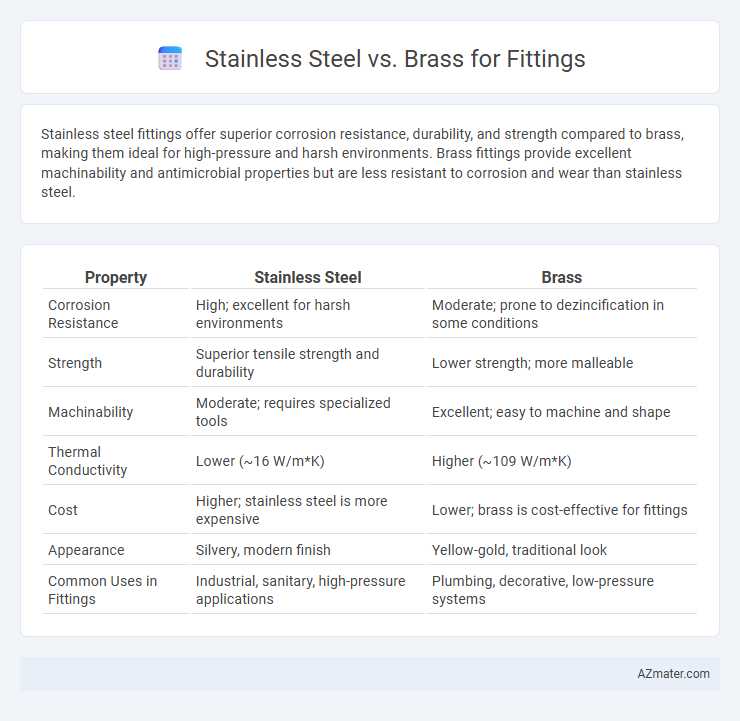Stainless steel fittings offer superior corrosion resistance, durability, and strength compared to brass, making them ideal for high-pressure and harsh environments. Brass fittings provide excellent machinability and antimicrobial properties but are less resistant to corrosion and wear than stainless steel.
Table of Comparison
| Property | Stainless Steel | Brass |
|---|---|---|
| Corrosion Resistance | High; excellent for harsh environments | Moderate; prone to dezincification in some conditions |
| Strength | Superior tensile strength and durability | Lower strength; more malleable |
| Machinability | Moderate; requires specialized tools | Excellent; easy to machine and shape |
| Thermal Conductivity | Lower (~16 W/m*K) | Higher (~109 W/m*K) |
| Cost | Higher; stainless steel is more expensive | Lower; brass is cost-effective for fittings |
| Appearance | Silvery, modern finish | Yellow-gold, traditional look |
| Common Uses in Fittings | Industrial, sanitary, high-pressure applications | Plumbing, decorative, low-pressure systems |
Introduction to Fitting Materials
Stainless steel fittings offer superior corrosion resistance, high strength, and longevity, making them ideal for demanding industrial applications and environments exposed to moisture or chemicals. Brass fittings provide excellent machinability, good thermal conductivity, and natural antimicrobial properties, making them suitable for plumbing and decorative applications where ease of installation and aesthetic appeal are important. Selecting between stainless steel and brass depends on factors like environmental exposure, mechanical stress, and cost considerations for optimal fitting performance.
Overview of Stainless Steel
Stainless steel fittings offer exceptional corrosion resistance, high strength, and durability, making them ideal for demanding industrial applications and harsh environments. Their resistance to rust, staining, and chemical damage ensures long-term reliability and low maintenance. Stainless steel's versatility across temperature extremes and pressure conditions further enhances its suitability for plumbing, automotive, and marine fittings.
Overview of Brass
Brass, an alloy of copper and zinc, is widely used for fittings due to its excellent corrosion resistance and machinability, making it ideal for plumbing and decorative applications. Its antimicrobial properties and attractive gold-like appearance provide both functional and aesthetic advantages in residential and commercial environments. While brass fittings offer good durability, they generally have lower tensile strength compared to stainless steel, impacting their suitability for high-pressure systems.
Mechanical Strength Comparison
Stainless steel fittings exhibit significantly higher mechanical strength compared to brass fittings, making them ideal for high-pressure and heavy-duty applications. The tensile strength of stainless steel typically ranges from 485 to 750 MPa, while brass generally offers tensile strength between 300 to 500 MPa. This superior strength in stainless steel enhances durability and resistance to deformation under stress, crucial for industrial and structural use.
Corrosion Resistance Analysis
Stainless steel fittings exhibit superior corrosion resistance due to their chromium content forming a passive oxide layer that protects against rust and chemical damage. Brass fittings, composed mainly of copper and zinc, resist corrosion well in freshwater and mildly acidic environments but are prone to dezincification and pitting in highly corrosive or saline conditions. For applications demanding longevity in harsh or marine environments, stainless steel outperforms brass, ensuring reliable structural integrity and minimal maintenance.
Cost and Longevity Factors
Stainless steel fittings offer superior longevity due to their exceptional corrosion resistance and durability, making them ideal for harsh environments despite a higher initial cost. Brass fittings, while more affordable upfront, may require more frequent replacement as they are prone to tarnishing and dezincification over time. Evaluating the total cost of ownership, stainless steel generally provides better value for long-term applications due to reduced maintenance and replacement expenses.
Installation and Maintenance Considerations
Stainless steel fittings offer superior corrosion resistance and durability, reducing maintenance frequency and ensuring long-term installation reliability in harsh environments. Brass fittings provide easier machinability and a smoother installation process due to their malleability but require more frequent upkeep to prevent tarnishing and dezincification. Choosing stainless steel optimizes longevity and minimal maintenance, while brass suits applications needing simpler handling and moderate care.
Common Applications: Stainless Steel vs Brass
Stainless steel fittings are widely used in chemical processing, food and beverage industries, and marine environments due to their exceptional corrosion resistance and durability. Brass fittings are commonly employed in plumbing, heating systems, and water supply lines because of their excellent machinability and moderate corrosion resistance. Both materials serve critical roles in fluid handling systems, with stainless steel preferred for harsh conditions and brass favored for ease of installation and cost-effectiveness.
Environmental Impact and Sustainability
Stainless steel fittings offer superior corrosion resistance and recyclability, making them a more sustainable choice with a lower environmental footprint compared to brass. Brass fittings, composed primarily of copper and zinc, have higher extraction impacts due to energy-intensive mining and less efficient recycling processes. Choosing stainless steel supports long-term sustainability goals through durability and reduced resource consumption in manufacturing and maintenance.
Choosing the Best Fitting Material for Your Needs
Stainless steel fittings offer superior corrosion resistance, durability, and strength, making them ideal for high-pressure and high-temperature applications, especially in industrial and marine environments. Brass fittings provide excellent machinability, good corrosion resistance in water systems, and affordability, which suits residential plumbing and low-pressure settings. Selecting the best fitting material depends on factors like environmental exposure, pressure requirements, and budget constraints to ensure long-term performance and safety.

Infographic: Stainless steel vs Brass for Fitting
 azmater.com
azmater.com